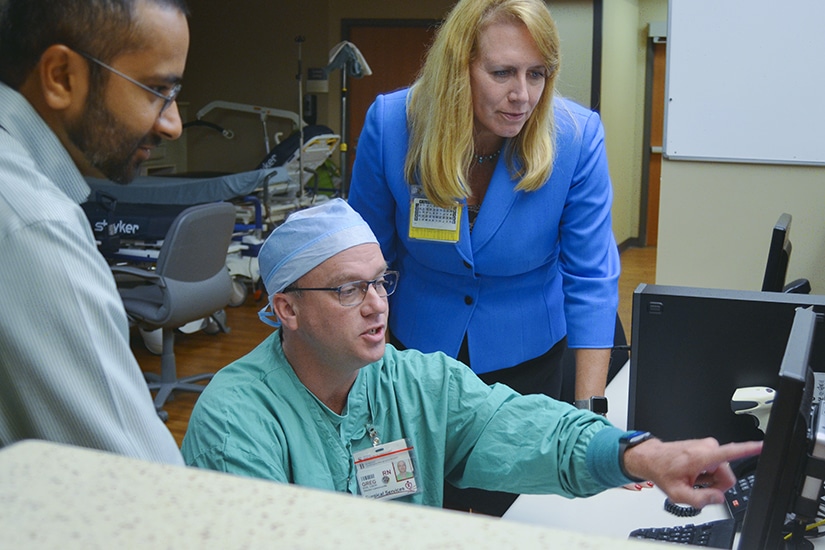When it came time to complete the sunsetting of Gwinnett Medical Center (GMC)’s existing EMR systems and to prepare for implementing its replacement, the hospital’s information technology and services department had only weeks to put together a team of more than fifty experts. That meant identifying specialists that could act as liaisons between the technology and the clinical practices that would need to be translated into the new enterprise-wide system.
However, the transition also has implications across the entire health system, not just GMC’s two acute-care hospitals. Gwinnett Health System (GHS), GMC’s parent company, also includes Gwinnett Medical Group—which comprises hospital-owned physician practices, among other entities—so a broad-based approach was required.
Nancy Stockslager, GMC’s senior director of applications and clinical informatics officer, spearheaded the efforts. ”Not only did we have to fill a large number of positions, but we had to fill them with exactly the right people,” she says.

To address that, departmental leadership met to identify characteristics among top performers in a variety of disciplines. After lengthy discussions, they came to agree that higher-level critical thinking was a common thread between these individuals. Those characteristics include rational, logical thought, plus efficient and effective process recommendations that lead to the best solutions.
“Someone with higher critical thinking skills can assess a situation, analyze possible solutions, and evaluate the impact of each one on multiple workflows and other important factors,” Stockslager explains. “That leads to decisions that best meet the needs of the entire organization.”
She and her team decided to rely on objective supporting data to help pursue this line of thinking. GHS already used Healthcare Source as a tool to measure critical thinking in candidates for management positions, but the team needed additional perspectives that were specifically focused on technology employees. That led to the addition of a separate critical thinking test. The two assessments were combined to develop a pilot study that recruited the department’s associate leadership council to test the critical thinking hypothesis.
Stockslager says the results were eye-opening. All the top performers on the council—who were previously recognized through past successes—demonstrated high measures of critical thinking on both assessments. Additional metrics showed high scores for openness to change, innovative thinking, customer orientation, and multitasking abilities.
“We didn’t expect so many different categories to be aligned,” Stockslager says. “The pilot results got more and more exciting because we were testing a theory that was becoming increasingly viable as we went along.”
The pilot study also demonstrated that top performers were also highly productive, and they were very well-rounded, including being good communicators. This was critically important because of the liaison responsibilities of the new team. “A highly analytical person with excellent problem-solving skills, but who doesn’t communicate well with users, wouldn’t be a good fit,” Stockslager adds.
With such positive results, critical thinking became an important screening tool in the hiring process. It was applied to both internal associates—who ultimately made up 30 percent of the new team—and external candidates, and was combined with personal interviews and additional behavior-oriented questions. This created a streamlined screening process that led to more than half of the interviewed candidates being hired.
The assembled EMR project team has already demonstrated itself to be a highly effective, cohesive, and diverse group, she says. Some members have just graduated from college while others are close to retirement.
Many team members have clinical degrees and licenses, as well as technology experience or informatics degrees. This enables each individual to align with the clinical organizations with which they work. And because they have in-depth insights into the processes and challenges, they can recommend the most current and appropriate technologies. For example, the team’s women’s health analyst is an NICU nurse, has an informatics degree, and also has a doctorate in nursing practice; the laboratory analysts are medical technologists; the inpatient nursing and ancillary team primarily comprises nurses or other clinicians. Stockslager herself began her career in nursing clinical practice in pediatrics and the NICU.
“Each one of us has an understanding of the processes and what the outcomes should be for each specialty,” she says. “That helps us find the most appropriate solution for each of our customers’ unique needs.”
Incorporating critical thinking into the hiring process of the EMR team has been so successful that Stockslager is applying it to other areas. It’s being adapted to help fill another management positions within the department, and new questions have been developed to highlight candidates’ responses to difficult scenarios that commonly occur in the role.
Stockslager points to two partners that have provided critical assistance in making GHS’s EMR transition a success. ROI Healthcare Solutions, which has provided complete support for managing the legacy and sunsetting systems, and CSI Healthcare IT, which has provided exceptional short-term staff to help supplement the EMR project team. It has also provided leadership, support, and guidance on the project for testing, training, and at-the-elbow support programs for the project.
Once the EMR conversion is complete, the new Cerner system will offer a single source for comprehensive patient information. “The EMR is helping introduce new tools to provide more efficient and higher quality care that will be better for patients and for our caregivers,” Stockslager says.

